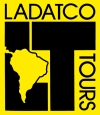

Destinations
Experiences
 |
L A
D A T C O T O U R
S |
 |
||||||||
| HOME | South America | Falkland Islands | Antarctica | Unique Destinations |
Unique Experiences |
Newsstand | ||||
 |
Chiclayo
Chiclayo Where to stay: |
 |
ABOUT CHICLAYO - from PromPeru:
Chiclayo is a part of Peru where the tropical sun, desert oases and the fresh sea breeze come together. Legend has it that the god Naylamp sailed here together with a vast retinue thousands of years ago to found his empire. In fact, many ancient civilizations saw the strategic advantage of controlling this region, which today is a major business hub in northern Peru, where routes come together from the coast, highlands and jungle. Chiclayo is the capital of the department of Lambayeque, which gave rise to the Mochica culture from 0-600 AD.
Near the town of Sipán, 35 km from Chiclayo, lies Huaca Rajada, a complex where archaeologists discovered the tomb of the Lord of Sipán, a high-ranking leader whose body was accompanied by gold relics and jewelry. The treasure trove is on exhibition at the Brüning National Archaeological Museum, where the Gold Room houses one of the finest collections of gold relics in the Americas.
Another major complex is that of Túcume, also known as the Valley of the Pyramids, as there are 26 of them. Visitors can take in archaeological sites and the natural landscape, as well as experiencing folk healing and a culture interchange in general, thanks to the active participation of the community in the preservation of their natural and cultural heritage.
Chiclayo also boasts some of the finest cooking to be had in northern Peru, serving up dishes such as arroz con pato (duck served with rice) and the local variation of cebiche (raw fish marinated in lemon juice). The city celebrates the festival of Santísima Cruz de Chalpón in February, which falls in summer in the Southern Hemisphere. This is a good time to visit nearby Pimentel, a modern beach resort which provides opportunities for water sports such as surfing. One can also watch how the local fishermen still breast the waves with the caballitos de totora, the reed rafts that have been used along the north coast for thousands of years.